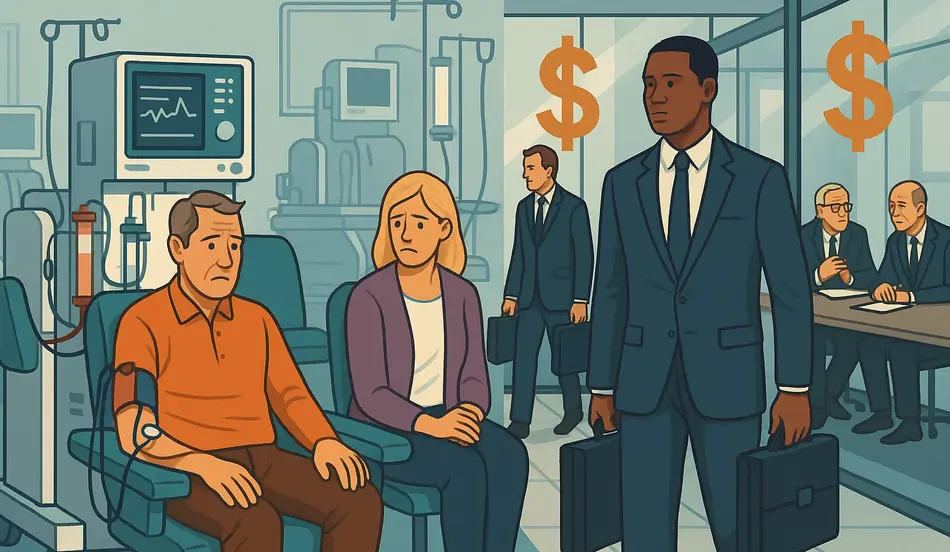The dialysis industry crisis has reached alarming levels as corporate giants DaVita and Fresenius control 80% of America’s dialysis market, prioritizing profits over patient care with dangerous understaffing, shortened treatment times, and aggressive cost-cutting that puts half a million Americans at risk.
The Hidden Reality Behind America’s Dialysis Industry Crisis
The dialysis industry crisis remains largely invisible to most Americans, despite affecting over half a million people who depend on these life-sustaining treatments. Two corporate giants, DaVita and Fresenius, have quietly established a duopoly that controls approximately 80% of dialysis facilities across the United States. This concentration of power has created a system where profit maximization often supersedes patient welfare.
“This is the future of healthcare,” former DaVita CEO infamously stated, comparing their dialysis centers to fast-food chains. “If I had 1,400 Taco Bells, and 32,000 people who worked in them, I would be doing all the same stuff.” This disturbing comparison reveals the fundamental problem at the heart of the dialysis industry crisis: treating critical healthcare as a profit-driven assembly line.
For the nearly 750,000 Americans who experience kidney failure annually, dialysis isn’t optional—it’s the only treatment available besides a kidney transplant. Yet the quality of this life-sustaining care has deteriorated dramatically as corporate consolidation has tightened its grip on the industry.
The Human Cost of Corporate Dialysis
Carmen, a former dialysis patient who spent 14 years receiving treatment at DaVita facilities, witnessed firsthand the decline in care quality:
“In 14 years, the quality of care diminished to the point where patients were having to suffer needlessly. They cut back on cleaning cost, leaving bloodstains on the floor and chairs. They took away the numbing medication.”
These cost-cutting measures represent just the visible aspects of the dialysis industry crisis. More dangerous are the systemic issues that put patients at immediate risk:
- Dangerous understaffing levels, with some nurses responsible for up to 17 patients simultaneously
- Shortened treatment times to maximize patient throughput
- Removal of safety measures and medications to reduce expenses
- Unsanitary conditions due to reduced cleaning protocols
- Pressure on staff to avoid calling ambulances during emergencies
Journalist Tom Mueller, who spent five years investigating the dialysis industry crisis and interviewed over 100 patients, workers, and kidney specialists, describes the situation in stark terms: “It is, and I’m not exaggerating, the most horrifying thing I’ve read in years.”
Corporate Profit Strategies in the Dialysis Industry Crisis
The business model driving the dialysis industry crisis follows a familiar pattern of corporate consolidation seen across American healthcare. DaVita and Fresenius have systematically acquired over 1,000 independent clinics, creating a near-monopoly that allows them to implement aggressive cost-cutting measures without fear of losing patients to competitors.
The Assembly Line Approach to Critical Care
Economist Ryan McDevitt, who has extensively studied the business practices of dialysis chains, explains how the assembly-line mentality endangers patients:
“You have patients on an assembly line, crammed in as rapidly as possible, and as many shifts as possible, to make the facility more profitable. But even when you’re trying to run dialysis like an assembly line, things happen.”
This production-line approach creates several dangerous practices:
- Shortened treatment times: Research conclusively shows that shortened dialysis sessions directly correlate with shorter patient lifespans. Yet to maximize throughput, clinics routinely cut sessions short.
- Against Medical Advice (AMA) forms: When patients’ treatments are cut short due to scheduling constraints, they’re often pressured to sign AMA forms, making it appear as though they chose to end treatment early—a practice that can later disqualify them from receiving kidney transplants.
- Ambulance avoidance: When patients experience medical emergencies during treatment, staff may hesitate to call ambulances because emergency transfers negatively impact the clinic’s quality metrics and potential Medicare reimbursements.
- Hospitalization rates increase by approximately 6%
- Death rates increase by about 3%
- Transplant rates during patients’ first year of dialysis fall by nearly 10%
Legal Troubles and Kickback Schemes
The dialysis industry crisis extends beyond patient care issues to include allegations of systematic corruption. According to McDevitt, the major dialysis chains have paid over a billion dollars in settlements and fines over the past decade:
“They’re paying kickbacks to nephrologists to get them to refer more patients to the facility… They view it as the cost of doing business. For them, it’s like paying the rent or paying employees.”
This practice ensures a steady stream of patients while discouraging independent competition, further entrenching the duopoly’s control over the industry.
Explore Healthcare Career Opportunities
Related Post: Explore Top Jobs on WhatJobs
- Find positions with healthcare providers prioritizing patient care
- Discover opportunities in nephrology and patient advocacy
- Access healthcare facilities with ethical staffing practices
- Connect with employers seeking dedicated medical professionals
- Receive alerts for positions matching your healthcare experience
The Devastating Impact on Patients and Workers
The dialysis industry crisis affects not only patients but also the dedicated healthcare workers trying to provide quality care within an increasingly broken system. Former dialysis technicians and nurses describe working conditions that make proper patient care virtually impossible.
Understaffing and Worker Burnout
Megallan Handford, a former LAPD officer who retrained as a dialysis nurse, described his workplace as resembling “a MASH unit in a war zone.” With staffing ratios that sometimes reached one technician for every seven to nine patients, workers find themselves constantly rushing between emergencies.
One Fresenius worker described the grim reality: “You’re just sitting there waiting to see what emergency is going to happen. I’ve bled out, and while I’m bleeding out, there’s a person across from me that is alarming. Who are they going to help first?”
This chronic understaffing creates impossible choices for healthcare workers and dangerous conditions for patients. When workers have raised concerns, management responses have been callous. As one worker recounted, “We were complaining because we were short-staffed that weekend, and nobody came to help, and [the manager said] ‘oh well, nobody died.’ That was the response.”
Patient Intimidation and Retaliation
Perhaps most disturbing in the dialysis industry crisis is the reported treatment of patients who advocate for themselves or raise concerns about care quality. Mueller’s investigation revealed a pattern of intimidation and retaliation:
“In my experience as a reporter, patients who speak out about their rights, patients who are a little bit difficult, patients who don’t agree immediately to be passive subjects of care are quite often targeted for intimidation, and sometimes pushed out of their clinics.”
For dialysis patients, being “pushed out” of a clinic can be a death sentence. With limited alternatives in many regions due to the duopoly’s market dominance, patients who are blacklisted may have no option except emergency room dialysis—a dangerous and ineffective alternative to regular treatment.
This fear of retaliation has silenced many patients. As Republican Senator Chuck Grassley noted during a hearing on dialysis 25 years ago: “They must dialyze to live. That fact alone has discouraged many patients interviewed by this committee from coming forward today to publicly testify.”
America’s Deadly Outlier Status in Kidney Care
The dialysis industry crisis has made the United States an outlier among developed nations in terms of patient outcomes. Mueller’s research revealed stark differences in mortality rates:
“Patients in America die sooner than anywhere else in the developed world. They have a 20% annual mortality rate. Compare that to Europe, which is 12 to 15, compare that to Japan, which is 6%. It’s radically, radically different. So American patients die 2 to 3 times faster.”
These statistics aren’t merely numbers—they represent thousands of Americans dying prematurely each year due to a profit-driven system that prioritizes shareholder returns over patient survival.
Attempts to Suppress Research and Criticism
When researchers or journalists attempt to expose the dialysis industry crisis, they often face aggressive pushback from the corporations involved. When McDevitt published his research showing increased mortality and hospitalization rates after corporate acquisitions, DaVita executives sent a lengthy email to journal editors attempting to discredit the work.
Similarly, when Mueller was preparing to publish his book on the industry, he received letters from corporate lawyers suggesting his reporting was “libelous”—what he and his publisher interpreted as an attempt to block publication.
This pattern of attempting to silence critics further insulates the industry from accountability and reform.
Hiring in Healthcare or Patient Services?
Post jobs for free with WhatJobs – Connect with certified, ethical, and patient-focused healthcare professionals.
Post a Healthcare Job Now →The Broader Implications for American Healthcare
The dialysis industry crisis represents a canary in the coal mine for American healthcare more broadly. The same patterns of consolidation, cost-cutting, and profit maximization are occurring across various healthcare sectors:
- Hospital systems acquiring independent facilities and physician practices
- Private equity firms purchasing and consolidating specialty practices
- Pharmacy benefit managers controlling medication access and pricing
- Insurance companies narrowing networks and increasing denial rates
As Mueller notes, “That’s one of the few things that everybody can agree on, right, left and center, is that our healthcare system is broken, and dialysis is just sort of the worst case scenario of what can happen when you totally focus on profits and on Wall Street, and turn the other cheek to human harm.”
The Fight for Reform and Accountability
Despite the bleak landscape, there are signs of resistance to the dialysis industry crisis. Workers at both DaVita and Fresenius have begun organizing with United Healthcare Workers to fight for better pay and staffing levels. Patients like Carmen, who was fortunate enough to receive a kidney transplant, continue advocating for better conditions for both patients and workers.
“They take care of us. They’re responsible for my kidney. My brand new kidney is going to be two years old tomorrow,” Carmen explains, highlighting the critical role dialysis workers play in patients’ survival.
Several states have attempted to introduce legislation requiring minimum staffing levels and quality standards for dialysis clinics. However, the industry has fought these measures aggressively, spending millions on lobbying and campaign contributions to maintain the status quo.
For meaningful change to occur in the dialysis industry crisis, greater public awareness and regulatory oversight will be necessary. As more Americans understand the deadly consequences of treating life-sustaining healthcare as a profit center, pressure for reform may finally overcome the industry’s resistance.
A Different Model Is Possible
The dialysis industry crisis in America stands in stark contrast to kidney care in other developed nations. Countries with universal healthcare systems typically provide longer, more frequent dialysis sessions with better staffing ratios. The result is dramatically better patient outcomes and quality of life.
Even within the United States, some non-profit dialysis providers demonstrate that a different approach is possible. Organizations like Northwest Kidney Centers in Seattle maintain higher staffing levels, longer treatment times, and more personalized care—proving that the assembly-line model is not inevitable.
The fundamental question raised by the dialysis industry crisis is whether life-sustaining healthcare should be treated as a commodity or a right. As one dialysis nurse put it: “Turns out that kidneys are a little different than a Crunchwrap Supreme.”
FAQ About the Dialysis Industry Crisis
What are the main causes of the dialysis industry crisis in America?
The dialysis industry crisis stems primarily from corporate consolidation, with DaVita and Fresenius controlling approximately 80% of facilities nationwide. This duopoly has implemented aggressive cost-cutting measures including dangerous understaffing, shortened treatment times, and reduced safety protocols to maximize profits. The business model treats dialysis as an assembly line rather than critical healthcare, prioritizing patient throughput over proper treatment. Additionally, the industry’s practice of paying kickbacks to nephrologists for patient referrals has further entrenched their market dominance while eliminating competition that might offer better care.
How does the dialysis industry crisis affect patient mortality rates?
The dialysis industry crisis has created a situation where American dialysis patients die at 2-3 times the rate of those in other developed countries. While patients in the U.S. face a 20% annual mortality rate, European patients experience 12-15% mortality, and Japanese patients just 6%. Research shows that when independent clinics are acquired by the major dialysis chains, death rates increase by approximately 3%. This increased mortality is directly linked to shortened treatment times, inadequate staffing, and prioritization of financial metrics over patient safety. The assembly-line approach to treatment has made America an outlier in kidney care outcomes.
What dangerous practices have emerged from the dialysis industry crisis?
The dialysis industry crisis has fostered several dangerous practices that directly harm patients. These include extreme understaffing (with some nurses responsible for up to 17 patients simultaneously), routinely shortened treatment sessions against medical recommendations, pressuring patients to sign Against Medical Advice forms when treatments are cut short for scheduling reasons, avoiding ambulance calls during emergencies to maintain favorable quality metrics, and retaliating against patients who advocate for better care. Additionally, cost-cutting measures have led to unsanitary conditions, removal of pain management options, and inadequate monitoring of patients during treatment—creating situations where patients can experience life-threatening emergencies without timely intervention.
How does the dialysis industry crisis affect kidney transplant rates?
The dialysis industry crisis has been linked to reduced kidney transplant rates, with research showing transplantation rates falling by nearly 10% when independent clinics are acquired by major dialysis chains. This reduction occurs for several reasons related to profit incentives. Dialysis companies earn consistent revenue from patients who remain on treatment, creating a disincentive to help patients transition to transplantation. Additionally, the practice of pressuring patients to sign Against Medical Advice forms when treatments are cut short can later disqualify them from transplant eligibility, as transplant centers are reluctant to allocate scarce organs to patients who appear non-compliant with medical advice. This system traps many patients in ongoing dialysis when transplantation would provide better outcomes and quality of life.
Conclusion: A System in Need of Transformation
The dialysis industry crisis represents a profound failure of American healthcare policy. By allowing critical, life-sustaining treatment to be dominated by profit-seeking corporations with minimal oversight, we have created a system that routinely sacrifices patient welfare for shareholder returns.
The statistics are clear: American dialysis patients die at rates two to three times higher than their counterparts in other developed nations. This is not due to differences in medical knowledge or technology, but rather to a fundamentally broken business model that treats healthcare as a commodity rather than a right.
As more Americans become aware of the dialysis industry crisis, pressure for meaningful reform may finally overcome the industry’s resistance to change. Until then, hundreds of thousands of kidney patients will continue to receive substandard care that shortens their lives and diminishes their quality of life—all to maximize corporate profits in an industry that should be focused on healing, not earnings reports.
For those concerned about the future of American healthcare, the dialysis industry offers a stark warning about the consequences of unchecked corporate consolidation and profit-seeking in essential medical services. As Mueller concludes, “The model is the same, buy up local businesses and aggressively cut costs. It doesn’t have to be this way. Nearly every other country in the world has figured this out.”




